BBC's Blog, page 15
June 29, 2013
BBC Sport: A weekend of digital coverage
It's hard to believe it's nearly a year since London 2012. After that incredible summer of sport, and what was generally regarded as the first true ‘digital Olympics’, we've been busy working on how we can roll out elements of that offer to the BBC's coverage of other sports.
This weekend we have a wealth of live sport running alongside our extensive coverage of Glastonbury which means that whatever your plans you'll be able to follow all our live sport and music across all your digital screens.

BBC Sport coverage across different devices
Our digital coverage of Wimbledon 2013 is the most extensive ever with a record 10 live streams available on computer, tablet, mobile and connected TV. If you didn’t know all the ways in which you can follow the action then this page should help you out.
It's been a frantic championship already including losing the likes of Roger Federer, Rafael Nadal and Maria Sharapova in the opening few days of the event and our exclusive column with Andy Murray has helped drive much off-court debate on his challenge match with Serena Williams.
Then for this weekend’s British Grand Prix as well as following the race live on TV and radio, Formula 1 fans will be able to customise their viewing experience online on the BBC Sport website through a live leaderboard, in-car cameras, choice of commentary, live text commentary, interactive forums, driver tracker and blogs.
You can also follow multi-platform coverage of all the action from the Diamond League Athletics in Birmingham and the Confederations Cup final in Brazil on Sunday.
Our ever popular live text commentaries on the BBC Sport website continue to combine updates from the action, analysis from BBC Sport pundits and the very best curated content from social media.
So while I will be at Silverstone on Saturday morning I know I won’t be the only person checking the latest scores and updates from the second Test from the British and Irish Lions using the text commentary on the BBC Sport smartphone app.
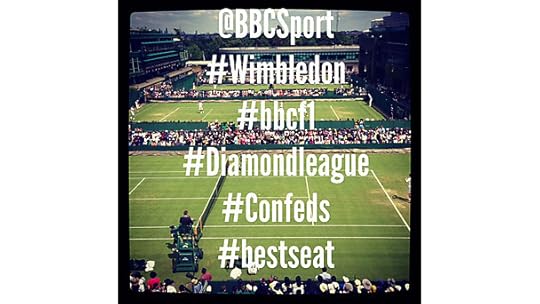
BBC Sport hashtags - follow the action
As part of our service to audiences we are also looking to provide a greater offering on social media than ever before. With a dedicated social media team now in place at BBC Sport for the first time, led by our new editor Chris Hurst, we are aiming to build on popular services such as @BBCSport, which already has almost 1.2 million followers, alongside growing accounts such as the BBC Sport Facebook page.
Just this week the BBC has launched its own Instagram account to help provide a behind the scenes look at major sporting events. Through our Wimbledon coverage we have also been able to present audiences with different experiences, experimenting with platforms such as Vine.
By engaging in new and creative ways of connecting with our audiences we hope to enhance the experience of those attending major events like Wimbledon, and for those not lucky enough to have tickets we are doing everything we can to try and make them feel like they are there.
In the coming months you'll see more social innovations, building on the live voting during our Confederations Cup broadcast where audiences have had their say via voting on the BBC Sport website or through a Twitter hashtag.
If you tune into BBC One for the final on Sunday night then follow @bbcmotd for more information on how to take part.
If you're watching Glastonbury on the BBC or our coverage of one of this weekend’s range of sporting events we'd love you to share your experiences with us using #bestseat and send your photos, vines or details on how you’re following one of the biggest weekends in the British calendar with us.
Meanwhile we'll have half an eye on next year too when the Winter Olympics, World Cup and Commonwealth Games will provide the opportunity to keep pushing on with our digital coverage of the biggest sporting events.
Ben Gallop is Head of BBC Sport Interactive and Formula 1.
June 28, 2013
What's on Red Button 29 June-6 July
Welcome to a jam-packed week on the BBC Red Button kicking off with our biggest weekend of the summer featuring unrivalled coverage of Wimbledon, Glastonbury and the British Grand Prix.
Wimbledon 2013
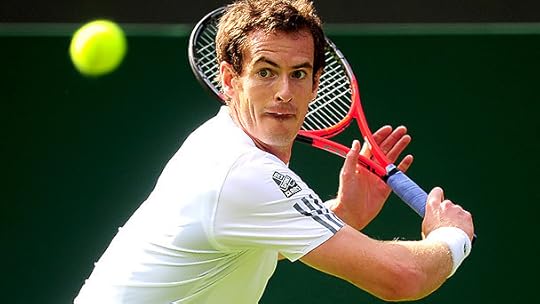
Andy Murray, Wimbledon 2013
You can follow all the live matches from the second week at Wimbledon plus highlights from each day's play.
Satellite and cable viewers can select from three additional live courts while viewers on Freeview, BT Vision or YouView can choose between two extra courts alongside the best of the action on BBC One and BBC Two. Just press red on any BBC channel, select Wimbledon 2013 and then choose your court by accessing the menu via the blue button.
The best of the action is available in HD on the Red Button HD channel on these services: Freeview HD 303, Virgin Media 994, YouView 303. Virgin TiVo users can access all 10 live courts in HD via the Connected Red Button along with highlights and interviews.
For a full guide to coverage, see Wimbledon 2013: How to watch on the BBC.
Motorsport
Other sport highlights in the first weekend include the latest Formula 1 coverage from the British Grand Prix at Silverstone including a view of Saturday's qualifying from the pit lane and MotoGP race action from Assen. For information on this week's schedule see the BBC Sport website. Please note times are subject to change.
Glastonbury

Pyramid stage crowd, Glastonbury 2013
This year the BBC is devoting more broadcast hours to the legendary music festival than ever before. Watch and listen to a huge range of performances live and re-live your favourite festival moments or ones you've missed from the six stages, which include the Pyramid, Other, John Peel, West Holts, BBC Introducing and for the first time The Park Stage. So if you can't make it to Worthy Farm this year, this is the next best thing.
Virgin TiVo users can access live performances and highlights via the Connected Red Button Glastonbury app. For a full guide to the all the festival coverage, please visit how to watch and listen.
Available on Freesat/Sky/Virgin Media/Freeview:
Sat 29 Jun, 9pm-2am
Sun 30 Jun, 4.30pm-2am
Available on Virgin TiVo:
Sat 29 Jun-Fri 5 Jul
How to Be a Powerful Woman
Watch short films featuring 15 of Woman's Hour's most powerful women in the UK – including artist Tracey Emin, athlete and Life Peer Tanni Grey-Thompson and Vogue editor Alexandra Shulman – who share their experiences, advice and philosophy for a successful working life.
Available on Freesat/Sky/Virgin Media/Freeview:
Tue 2 Jul, 10.40am-11.15am
Rick Stein's India
Rick's culinary odyssey celebrating the tastes and people of India continues from Monday evening with some tasty extra morsels from episode three. The chef travels deeper into the wetland system around India’s longest lake Vembanad. Here aquatic life is key and the surrounding communities make their living from the bounty that thrives under the lake's calm surface. In this Red Button extra Rick visits Vaidhay’s eatery, a small café for workers that is minutes from the lake. Here lunchtimes are sacred and Rick observes the cooks making the café's speciality dish, a mouth-watering clam masala.
Available on Freesat/Sky/Virgin Media/Freeview:
Mon 1 Jul, 9.55pm-10.30pm
Don't forget you can follow us on Twitter at @BBCRedButton.
College of Production Roundup: Make the most of YouTube and online drama with a culinary twist
I’m Ben Toone, assistant content producer at the BBC College of Production (CoP) website.
Our site is a free online learning resource for the radio, television and online production community offering videos, podcasts and articles from broadcasting innovators and experts.
Have you heard of Jack Harries? Two million plus subscribers to his JacksGap YouTube channel have made him something of a YouTube celebrity. He, along with Food Tube’s Richard Herd and Earth Unplugged’s Chris Howard gave their advice on how to run a successful YouTube channel in our podcast.

Jack Harries, Richard Herd and Chris Howard chat about running successful YouTube channels
From making the content short and snappy to maintain the audience’s attention to collaborating with other YouTubers, making best use of features such as annotations and playlists and their preferred equipment to use - with YouTube pushing to take on TV and be the place that people come to watch video, TV producers should take note!
From factual short-form content on YouTube to online drama with a culinary twist. Sandy Nicholson talks about how he wrote and produced Comfort Food, the world’s first cooking show with characters and a plot.
The series was funded by crowdsourcing with fans donating towards the production of the series after watching a pilot. It’s a continuing trend with many low budget film-makers turning to the fans to raise funds through sites like Indiegogo or KickStarter and broadcasting on the web rather than pitching to traditional broadcasters.
The added bonus with this approach is that you actively engage with your audience, something that resulted in the Comfort Food team being deluged with pictures of desserts made by the audience as they watched the show!
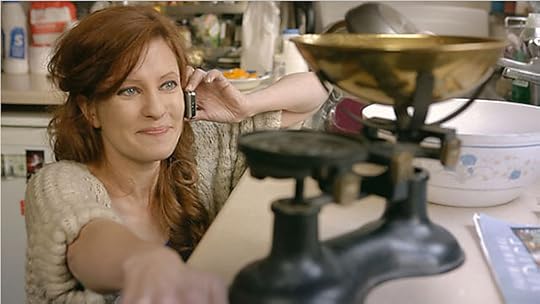
Comfort Food: the first cooking show with characters and plot
“Keep your profile relevant to the work you want and the professional you are”. Sound advice from our editor Paul Buller as he delivered a workshop on getting your career profile noticed online to a live audience and on Twitter at the Bectu Freelancers’ Fair.
From choosing the right platform to how to present your ideas and content, we’ve storified all the questions and useful tips, not only from Paul but from our ever helpful and resourceful @BBCCoP Twitter followers.
Finally, a quick word on Digital Cardiff: a week-long event looking at digital ideas and innovation for the Welsh creative industries. Welsh broadcaster S4C live streamed from the event with sessions up on YouTube.
BBCCoP and @TheBBCAcademy live tweeted #digitalcardiff from the event and there’ll be some articles to follow. You can find out more about one of the innovative online drama’s featured on one of Monday’s talks, Pobol y Cwm spin off PyC, in our podcast.
Ben Toone is assistant content producer for the College of Production website.
Voyager: An epic journey for UX&D
Hello my name is Josephine and I am a design trainee with UX&D (User Experience and Design).
How do you make a graphic of something as big as our Solar System and how do you make it work on desktops and tablets and all the way down to the tiny screens of older mobile phones?
Recently I aimed to answer the above questions when I worked with the Visual Journalism team on a project to visualise the journey of NASA’s Voyager spacecraft.
Check it out on this page.

Voyager infographic and calculator on different screens
I helped create an interactive infographic that depicts Voyager’s journey through our Solar System and a calculator feature that allows users to compare their commute time with Voyager’s journey. The feature also provides information about the celestial objects and different points of interest Voyager encountered along its path.
The challenge of this piece of work lay in designing a responsive treatment for a complex set of information and Voyager offered us a fantastic opportunity to dive head first into a longer-term project that would explore responsive-design thinking in depth.
Like many projects Voyager was a collaborative effort. I worked closely with journalists John Walton and Christi Sodano, UX developers Tom Maslen and Steven Connor as well as editorial designer Helene Sears.
We began by addressing how to make the piece personally relevant to the user. After discussions it was decided that an engaging strategy would be to allow a user to compare something personal, such as their daily commute, with Voyager’s path. A user could have their commute details contrasted with the Voyager’s journey through the Solar System.
For example, if a user has a five kilometre commute to work over 30 minutes the personal calculator would show that it would take them an astonishing 171,977 years at 10km per hour to travel to where Voyager is now and yet Voyager could have completed the user’s commute in a mere 0.26 seconds. Just a snapshot of how far and fast Voyager is speeding along!
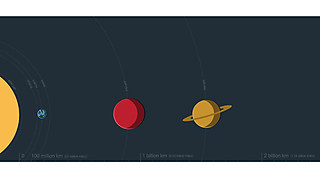
Detail from the long graphic
As well as the calculator we designed a long space graphic to illustrate Voyager’s route past various celestial objects. This was the longest file I have ever attempted – stretching to 10,331 pixels. The illustrative style adopted for Voyager was that of simple clean graphics that sat boldly against a colour palette of dark ‘space’.
The highest priority was given to maintaining a clear visual hierarchy so that the user could interact with the information panels and easily navigate through the piece.
This illustrative approach included visual subtleties such as the planetary shadows and animations that illuminated selected objects (on the desktop version only). Creating a completely solid colour background for the entire page formed the immersive backdrop appropriate to the space theme.
Close collaboration with developers during the responsive design process allowed us to negotiate the feasibility of the design as it was adapted across various sized screens.
Designing responsively forced us to prioritise components so we could then cater for users on basic feature phones and progressively enhance the user-experience on smart phones, tablets and desktop screens depending on device capabilities.
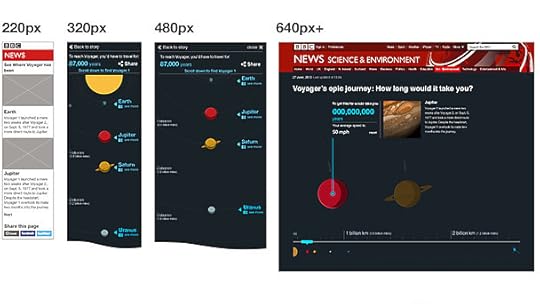
Views on different screen sizes
In other words, we needed to specify WHAT the message was and HOW it could be expressed on different devices.
In this case that meant adapting the calculator to match different device capabilities. For instance, feature phone users received their static calculated results at the top of the infographic, while users with newer smart phone models were able to experience the calculator dynamically, adjusting its calculation based upon their location in the long infographic.
From the perspective of a design trainee this exercise was invaluable. It hopefully means that future design processes will follow this route and ensure that the visual design stays grounded around the overall message.
Another responsive solution included altering the vertical scrolling action on mobile so it displays as a horizontal scroll on desktop to take advantage of the increased screen real-estate.
In a similar way, the touch screen interactions possible on smart phones meant that information panels could be revealed through the touch action on certain visual items. This prevented the information panels from cluttering the limited screen space.
By contrast, users on desktop will notice that as they scroll through the infographic the information panel remains stationary on the page while its content changes. This was again a decision to provide appropriate information as determined by the device’s capabilities.

Text and graphic detail
Specifically for mobile, the delivery of the long vertical graphic meant designing to a minimum dimension of 320 pixels wide to accommodate the narrowest mobile screens and ensuring that graphic items remained centrally aligned as the mobile screen sizes expanded to 640 pixels.
These decisions were based on striking the right visual balance for the right screen and the ease in which these solutions could be implemented.
Throughout the design process user-testing played a significant role, in this case ‘guerrilla testing’ where we approached individuals around BBC New Broadcasting House to see how they would interact with prototypes for both mobile and desktop.
As user-testing was carried out at different stages of the design process it focused on specific issues as they emerged. User-testing was therefore a valuable source of feedback which was often taken into consideration when refining the design.
The opportunity to assist the Visual Journalism team in tackling this interactive infographic has been a great way to explore the challenges of responsive design, the value of user-testing, and the advantages of collaboration between designers, developers and journalists alike. Thank you to the team and all who contributed.
I hope you’ve had a chance to explore the Voyager infographic and it would be great to hear what you think.
Josephine Lie is a design trainee in BBC UX&D and you can try it out yourself on BBC News Science & Environment.
Promotional Panel for Connected Red Button: Glastonbury and Wimbledon
I’m Jennifer Lyons, product manager for Connected Red Button in BBC TV and Mobile Platforms, Future Media.
Today I wanted to tell you about some exciting new features in the Connected Red Button and how this is going to give viewers more access to live events on the BBC.
Connected Red Button is currently available in Virgin TiVo homes by pressing the red button on the remote when watching a BBC channel on television, much like the hugely popular traditional Red Button service.

The promotional panel on Connected Red Button
In preparation for the big events this summer we rolled out a new version of Connected Red Button earlier this month which includes a promotional panel to the left of the main screen containing prominent links to additional BBC coverage of live action, events and programmes.
This promotional panel gives you quick and easy access to the most relevant and popular content available on the BBC and within only a few clicks on your remote you can be watching major events like Wimbledon, viewing the court of your choice, on the best screen in the house.
This new feature brings together the much loved Red Button content to the connected world, enabling us to bring the best of the BBC online and TV together.
Why press red?
You will regularly hear presenters promoting traditional red button content on air but this is the first time Virgin TiVo viewers can ‘press red’ to enjoy this additional BBC content as well.
This content will often be related to the programme the viewer has just been enjoying such as Springwatch, where you can watch the live webcams on red button, or special events such as BBC at Glastonbury and live sports coverage.
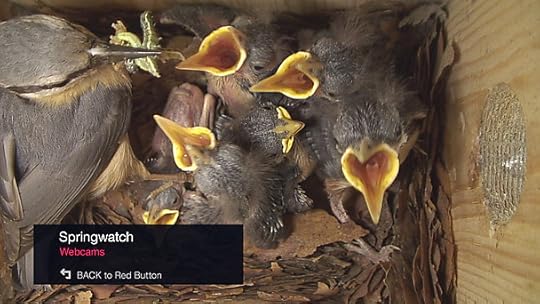
Springwatch web cams on the Connected Red Button
Our target launch date for this new release was early June and with good reason. Our challenge was to ensure that our viewers had access to as much of the BBC’s coverage during this fantastic summer of live sporting and music events as possible.
This weekend we will be promoting the live tennis at Wimbledon, live stage action and highlights from BBC at Glastonbury and the Formula 1 British Grand Prix. Each of these events will be available to watch over this weekend via the promotions panel.
Bringing the best of BBC online and TV together
Since our launch in December 2012 we have continually tested our Connected Red Button service with our audience and gathered feedback. The results consistently told us that the ability to watch more live events and ‘press red’ for more programme related content was at the top of our audience’s wish list.
It was also important for us to gain some parity with the traditional red button enjoyed by viewers of Freeview, Freesat, Sky and Virgin Media. These viewers already have the additional content via the Red Button such as Radio 1’s Live Lounge, Final Score and Dragons’ Den extra footage and the Virgin TiVo audience was clearly asking for this too.
The timing of the new feature was also important as we have been working with the wider BBC Distribution team on additional Red Button streams over the summer. This will give our viewers of Connected Red Button on Virgin TiVo even more coverage of the major sports and music events, see Alix Pryde’s blog post for more information.
In order to see this content you need to have both Javascript enabled and Flash Installed. Visit BBC Webwise for full instructions. If you're reading via RSS, you'll need to visit the blog to access this content
We worked closely with our colleagues across the BBC to ensure that we shared this vision between us and they have been instrumental in providing the content to support this feature. See more on the Red Button editorial content in Ian's post.
More from Connected Red Button
The future of Connected Red Button is an exciting one as we develop more features for current viewers and roll out to Smart TVs at the end of this year and more operator platforms in 2014.
We hope you enjoy this new feature and are looking forward to all the BBC coverage of the events coming up this summer. I will certainly be enjoying it all from the best seat in the house, my sofa!
Jennifer Lyons is the product manager for Connected Red Button.
Find out more about Digital Glastonbury: From stage to smartphone and how the BBC are using social media to cover the weekend.
June 27, 2013
Digital Glastonbury: From Stage to Smartphone
By the time you read this I'll be in a field on Worthy Farm, Pilton getting ready for the return of Europe's biggest festival. The BBC has been the exclusive broadcast partner of Glastonbury Festival since 1997 and in those 16 years we've shared some of the most incredible musical moments from that farm in Somerset.

This year you'll be able to see more of Glasto than ever before on whatever device you like, the first truly digital Glastonbury.
We're beaming six stages of live music back from Glastonbury and distributing on mobiles, tablets, computers, and via the Connected Red Button so you can watch it live or on-demand. I thought you might be interested to read about how we're doing that and how we approached building the website you'll be using to watch it.
The fun all starts in the (hopefully dry) fields of Pilton. BBC TV crews will shoot and mix live at the six stages and send these feeds via satellite back to White City in London.
Those TV signals will then be sent via our online team in Shepherds Bush (who add some graphics and check the quality etc) up to MediaCity UK in Salford. There our friends in BBC Sport will encode the video and send it out on to the web.
It's a very similar process to the one we used during the London 2012 Olympics. In fact the video will be encoded on the exact same systems that were used to bring you the action from the Games last summer.
With our video signals happily sitting in the cloud we then stream them via a video player on to the BBC Glastonbury website on your favourite device. We've built on the core of the video player that was used at the Olympics to bring you a really cool 'theatre mode' on PCs and iPads - put it in fullscreen and flick between the streams at your leisure.

Glastonbury on different screens
It’s the first time we’ll be able to move the editing and compliance processes for Glastonbury to our team in White City thanks to a handy piece of kit called Stagebox, developed by my colleagues in BBC Research and Development.
Stagebox means we can send broadcast-quality video up to our friends in Salford over the Internet, substantially reducing costs and the complication of booking broadcast lines between the two buildings.
I'm really proud of the work we've done to make the Glastonbury website look amazing whatever device you're using. We've completely redesigned the webpages led by a philosophy known as Responsive Design.
Whereas in the past we might have made a separate, lesser mobile site, this Glastonbury website is technically the exact same page wherever you load it.
Responsive design means it responds to the height and width of the screen you load it on and to environmental factors such as orientation and the presence of a touchscreen. (Once the weekend gets going, check out our fullscreen photo galleries on your mobile or tablet - swiping through those beautiful action shots is one of my favourite features.)
The Red Button has been a hugely important part of our Glastonbury coverage for the last few years. At the last Glastonbury 4.5 million pressed red for extra choice.
This year there’ll be three red button channels available and for the first time we’ll be streaming on the BBC’s Connected Red Button service. Connected Red Button launched in December. At the moment, only available on the Virgin TiVo platform, it's a really exciting glimpse of the potential of connected TVs.
If you have the Connected Red Button you'll be able to press red and access all the Glastonbury video streams and on-demand videos. And just as we've aimed to make sure all web users have access to the same content, Connected Red Button viewers will too. Literally the exact same video assets are available there, all powered by the same feeds and same tools as the website.
Everybody uses their devices differently and our aim has been to make a flexible experience that you can mold around the way you want to watch Glasto. You can watch on your phone on the move, on your tablet in bed, at your desktop computer or in your lounge on the Connected Red Button. Or all of the above. At the same time!
Right, I better go and pack my wellies. I really hope you enjoy the first truly digital Glastonbury festival, with access to more music whenever and wherever you want it. We’d love to hear your stories about what you watched and where – use the comments below or tweet us on @BBCGlasto.
Sam Bailey is interactive eEditor, Music Events.
Contact The BBC: New look page
Hello, I’m senior editorial development manager in BBC Future Media. One of my responsibilities is looking at how BBC Online can be more joined-up for our audiences.
Today we’re launching a new portal page for anyone who wants to Contact the BBC which will be linked to from the footer of each BBC web page.
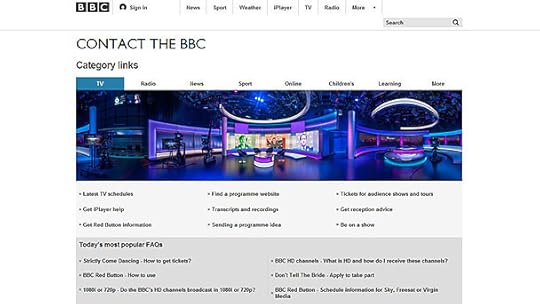
The new look Contact the BBC page
I’ve been working with my colleagues in Audience Services who handle the many contacts the BBC receives each year. They have found that although people are often visiting the site to offer praise for our content, this can soon turn to vexation when they can’t find the right information or area.
On the new look pages we’ve created a set of categories (TV, Radio, News etc.) to make it easier to direct people to where their specific needs will be best met – whether that’s to contribute to a Radio 5 Live debate, commenting on our News coverage, or anything else you may want to get in contact with us about.
We’ve also added a list of the most popular FAQs related to the TV, Radio and Online categories.
We’ve also tried to make it easier to find the area you may want by filtering the different forms of contact – do you want to comment, contribute or complain, or just get more information? You’ll find links which relate to each of these types of contact.
The page has been designed responsively so that it works equally well on both tablets and mobile a devices.
The next step is to create a new site for our FAQs using a similar design and principles which should go live in the near future.
The new site has been created with the input of my colleagues in Future Media User Experience and Design and we hope it makes your experience more satisfying and leads to a swifter response from us.
We hope you like it and please let me know what you think by leaving a comment below.
Jonathan Murphy is senior editorial development manager in BBC Future Media.
June 26, 2013
BBC Weather app reaches one million downloads
Recently I wrote about the launch of the BBC Weather apps for Android and iOS and I’m delighted to announce the app has reached over one million downloads across both platforms within the first two weeks of launch.
It’s great to see such a positive response to the app and to reach this milestone in extra quick time. I wanted to take this opportunity to share some insights into how people have been using it so far, as we’ve already started to see a shift in BBC Weather mobile usage.
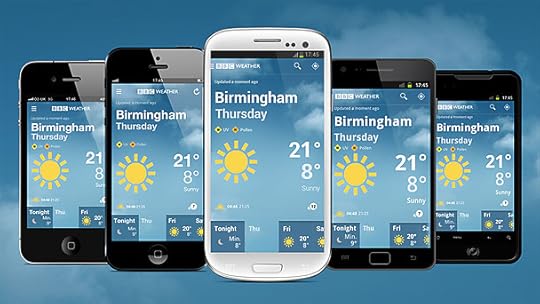
The BBC Weather app on different devices
For example, over 25% of people are now accessing our services via mobile, up from 20% prior to the apps launching.
In the first weekend following the app’s launch (15 and 16 June) we saw an approximate 47% increase in mobile access compared to the previous weekends number of mobile visits.
This was likely driven by people familiarising themselves with the new app and because the weather was especially changeable that weekend, with a real mix of sunny spells and showers.
As a result the hourly forecast feature was widely used as people kept track of the conditions and this feature drove 84% of the total mobile traffic over that weekend.
One of the other interesting trends we’ve noticed so far is how people use the BBC Weather app as part of their daily routine.
The most popular time for checking the weather is first thing in the morning between about 6 and 9am as people get up and start to prepare for the day and we see about 28 people per second requesting weather information.
Usage dips around 10am before a small peak at lunchtime, no doubt because people are checking to see if there’s a chance for an al fresco lunch.
As we approach the evening and prepare to head home we see a peak of 25 requests a second at around 6pm as people check to see that they don’t get caught out whilst making the most of the light nights, before the majority of users start to switch off from around 10pm.
Sunday evening is also proving a popular time to check the app as we again see about 25 requests a second as users look ahead and prepare for the week to come.
When we launched the app many of you commented on the things you liked, the things we could improve and some ideas for future features. All the feedback has been extremely valuable and we’re already starting to address some of it.
It’s clear that many Android users like the homescreen widget but would also like a variety of widget sizes and we hope to introduce these soon. We are also looking at ways to improve how the app finds and displays your location.
Please continue to send your comments, we really appreciate all your feedback and are reading all responses, but as there are so many it is not possible to reply to all that we get.
You can leave comments via reviews in Google Play and the iTunes app store, via twitter @BBCWeather, via our contact form or leave a comment below.
James Metcalfe is the senior product manager for the BBC Weather website.
June 25, 2013
Vote 2013: Agile vs. Waterfall
Hi I’m the project manager on the Vote 2013 election product. You can find out more about the product in my colleague Jonathan’s blog post.
Here I am going to tell you about the way I managed this project which utilised a number of new technologies and tools to put in place a solid foundation for the next three years of election coverage on News Online.

News coverage of the elections on Vote 2013
As the project manager I was responsible for leading the software development teams and delivering functionality in line with the product priorities.
I was also responsible for actively managing Risks and Issues, reporting progress and project status, planning the delivery and support for election night and being the primary point of contact for all of the other teams we worked with throughout the project.
At the start of the planning phase we looked at the needs specific to the election project and of our major stakeholders. We took the structure and governance of traditional project management and at the same time applied agile development practices to build the software.
This combination was an approach which met the needs of our stakeholders and enabled us to deliver a highly complex system on time.
Why did we need to do this?
Firstly, we were working to a fixed deadline of Election Day: 2 May 2013, a fixed minimum scope (the requirement to provide up to date and accurate information to audiences) and a fixed budget.
Secondly, there were a number of other departments we depended on or were dependent on us: our editorial team, the Red Button team, the data provider and our colleagues over in Core Engineering who provided the platform tools that enabled us to make full use of the cloud.
Thirdly, we weren't just building an application to run the UK 2013 local elections, we were putting in place a strategic platform for the elections coming up over the next few years. We were also building it responsively for mobiles and tablets, for our desktop users and our Red Button service.
And finally, we had to deliver it which means monitoring it, briefing our Operation Support teams on the system and the elections themselves and carrying out end to end data rehearsals alongside our colleagues in TV.
This necessitated having a really tight and aggressive timeline, defining key milestones, actively managing a comprehensive Risk log, implementing a solid communications plan and having appropriate governance in place such as Steering Groups and weekly reports.

Sprint board
Sounds like waterfall right?
We also needed the flexibility to define and refine requirements, to review and revise scope based on the emerging software, to prioritise based on a backlog, to develop iteratively, to measure velocity and provide regular demos to Jonathan Austin, our product manager, and other key stakeholders.
In other words all of the key aspects of an agile delivery approach.
Many of my fellow professionals take an either/or approach to agile vs. waterfall: that they are mutually exclusive or that only agile is appropriate for software development projects.
My view is why throw the baby out with the bath water? Indeed it completely fails to acknowledge that agile is not a ‘process’, it is a mind-set and a cluster of core principles and development techniques.
Likewise you can use ‘traditional project management’ techniques without necessarily utilising a waterfall delivery approach. I say take the best of each, based on the specific needs of your project and layer them on top of each other.
Here's how we did it
We started off with a high level timeline, marked out our delivery date and worked backwards to define milestones and development time. At the same time our product manager was busy putting together the vision, the high level requirements and defining the Minimum Viable Product (MVP).
The milestones we put in were vague enough to enable us to use an agile delivery approach whilst at the same time putting in place useful checkpoints at key dates along the delivery timeline. For example: Results Data Schema delivered, or Product Proposition Checkpoint.
We didn't lock down requirements: we started with a product brief and detailed analysis of the highest priority deliverables whilst iteratively defining the rest ‘just in time’.
UX worked iteratively with the business analyst and product manager and sat with our front end developers to tweak and refine in a real environment.
We used the Steering Group to communicate and demonstrate the emerging product that was built so far. Significant blockers or potential blockers within the development teams were added to the Risks, Issues, Assumptions and Dependency (RAID) log for communication and to aid any escalation activities required. This RAID log was also used as a basis for defining the project's RAG (Red, Amber, Green) status in a meaningful and less subjective (or ‘gut feel’) way.

Issue Status each month
Within the development team we also had some challenges to overcome. There were two distinct skillsets working on two separate bits of the system and interacting purely on a shared API.
It's best practice to carry out planning sessions with the whole team, however the clear split between development meant that this wasn't really practical. So we divided the team into a backend (Java) team and a front end (PHP) team both working in two week sprints on an alternating basis.
The presence of the product manager and the business analyst in both teams ensured consistency and the collaboration between our developer in test and our front end tester ensured the system met the requirements for all scenarios.
As a result of taking this approach we were able to meet the challenge of implementing the first step in the evolution of the election system. The event itself ran like clockwork and due to the careful planning and smooth delivery of the technology neither the project team nor our stakeholders had any surprises or last minute technical issues to overcome.
As a project manager there is nothing more rewarding than working on a project where everything goes to plan.
If you would like to comment on why a hybrid approach got my vote, please leave a comment below.
Hannah Mitchell is the project manager on the Vote 2013 election product.
June 21, 2013
What's on Red Button June 22-29
This week on BBC Red Button, watch coverage of the 2013 Wimbledon Championships and music from Glastonbury, the greatest festival in the world. Rick Stein returns with more culinary delights from India and there's another chance to join in the celebrations of 100 Years of Bollywood.

Centre Court
Wimbledon 2013
You can catch all the latest drama at Wimbledon 2013 on the Red Button this week.
Satellite and cable viewers will be able to select from three additional live courts, while viewers on Freeview, BT Vision or YouView can choose between two extra courts alongside the best of the action on BBC One and BBC Two. Just press red on any BBC channel, select Wimbledon 2013 and then choose your court by accessing the menu via the blue button.
And the best of the action will be available in HD on the Red Button HD channel on these services: Freeview HD 303, Virgin Media 994, YouView 303. Virgin TiVo users can access all 10 live courts in HD via the Connected Red Button along with highlights and interviews.
For a full guide to coverage, see Wimbledon 2013: How to watch on the BBC.
Other sport highlights this week include the latest from the Confederations Cup in Brazil, as well as F1 and MotoGP coverage. For information on this week's schedule, see the BBC Sport website. Please note times are subject to change.

Bobby Gillespie
Glastonbury 2013
The BBC is broadcasting more of the festival than ever before. Music fans will be able to watch and listen to a huge range of performances live and relive their favourite festival moments or ones they’ve missed. This is the next best thing for everyone who can’t make it in person to Worthy Farm. BBC Red Button will bring its audiences even closer to the music they love at Glastonbury.
For a full guide to Glastonbury coverage, please visit how to watch and listen.
Available on Freesat/Sky/Virgin
Media/Freeview:
Fri 28th June, 9:00pm-2:00am
Sat 29th June,
9:00pm-2:00am
100 Years of Bollywood
Indian cinema's centenary celebrations continue on BBC Asian Network with a special Red Button programme that brings you highlights of 100 Greatest Bollywood Songs, BBC Three’s Bollywood spin on Bizet’s classic opera Bollywood Carmen and film icons who recently visited the UK including Jackie Shroff, Zeenat Aman and Ranbir Kapoor talking about their contribution to the biggest film industry in the world.
For more information and the full schedule, click here.
Available on Freesat/Sky/Virgin Media/Freeview:
Sat 22nd June, 6:00am-7:00am, 3:45pm-7:30pm, 10:00pm-6:00am
Sun 23rd June, 6:00am-6:00pm, 7:00pm-7:55pm, 9:00pm-10:00pm
Mon 24th June, 12:00am-11:30am
Rick Stein’s India
Discover a wealth of regional Indian cooking with Rick Stein in Mumbai. With around 20 million inhabitants it’s the most populated city in India – possibly the world – with an abundance of produce and a variety of ethnic influences. For a chef wanting to pick up new ideas (especially seafood dishes) there’s no better place and Rick happened to find himself in Mumbai at the same time as friend and fellow chef Atul Kochhar. Together they visit Mumbai’s oldest Mangalorean restaurant, famous for its seafood dishes.
Available on Freesat/Sky/Virgin Media/Freeview:
Sat 22nd June, 11:55am-12:30pm
Mon 24th June, 9:55pm-10:30pm
Horrible Histories Karaoke
Grab your hairbrush, take a trip back in time and sing along with the biggest names in history. From Vikings to Dickens, Joan of Arc to Rosa Parks, rock your socks off to the CBBC Horrible Histories Karaoke!
Available on Freesat/Sky/Virgin Media/Freeview:
Sat 22nd June, 7:00am-11:55am, 12:30pm-2:45pm
Antiques Roadshow play along
Join in with Antiques Roadshow by guessing the valuations via the Red Button play along for the final time this series. You can also play along on a mobile or tablet by downloading the play along app. Don't forget to tweet your scores to #antiquesroadshow.
Available on Sky/Freeview:
Sun 23rd June, 7:55pm-9:00pm
BBC's Blog
- BBC's profile
- 28 followers



